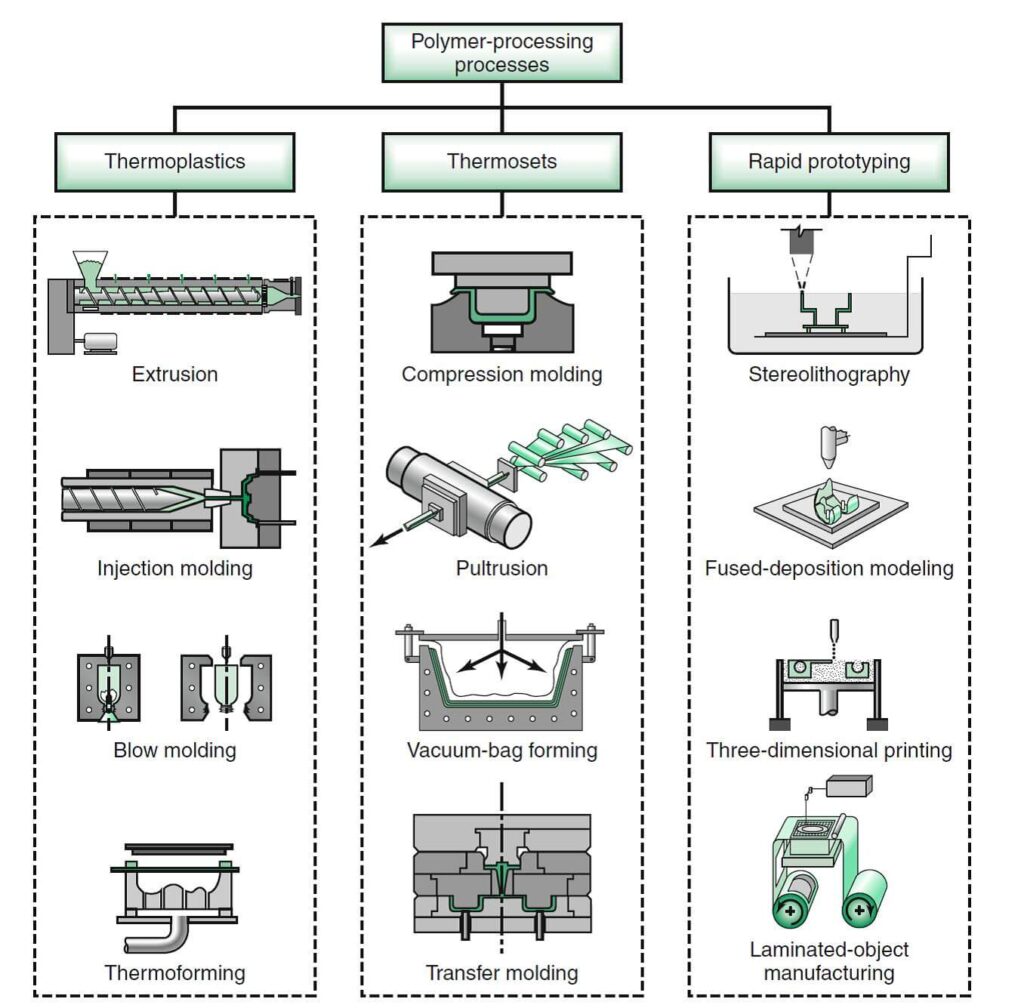[toc]
Various Plastic Molding Process
There are many similarities between the plastic molding and metal molding. A liquid or semifluid state of plastic is formed by heating and pressing it into a mold. The following sections provide an overview of some of the most popular molding processes.
Injection Molding
Plastic injection molding is used to make the majority of plastic parts. An injection mold fabricates plastic products by feeding powdered or granular plastics through melting and metering stages to a hopper before injection. A solidified part is ejected from the mold after it has cooled briefly.
Blow Molding
Plastic bottles and other hollow, lightweight parts are molded using blow molding. It is possible to blow mold by injection or extrusion.
Containers of all sizes are primarily blown by injection. Plasticized material is injected around a hollow mandrel to create a parison (molten-plastic pipe or tube). Upon being transferred from the mandrel to the blowing mold, the molten product is inflated with air as it is still on the mandrel. Accurate threads may be formed at the neck.
Metal molds are inflated with parison by extrusion-type blow molds under relatively low pressure. Die is pushed into the top mandrel, enveloped by pinching action. Inflation of the plastic occurs from the warm wall inflating a small amount of air into the mandrel. A bottle is ejected from the molds, and its tailpiece appears to fall off.
Extruding
Like metal extrusion, plastic extrusion utilizes hot materials (plastic melt) that are forced through a die that has an opening designed to shape a required cross-section. Temperatures of 250 to 600°F (121 to 316°C) are used for melting thermoplastic barrels, depending on the material.
A screen pack, located at the end of the extruder barrel, is used to build back pressure and filter the extruded material. As the helical flow exits the screen, the breaker plate holds it in place and straightens it out.
Overmolding
In injection molding, one thermoplastic is wrapped around another thermoplastic inside a solid skin. The material usually occurs on the skin surface and in the core is what blows.
There are three types of channels that can be used in processes. One-channel technology involves injecting two melts at the same time into the mold. If the settings for the parameters are correct, dense skin forms when the skin material cools and adheres to the colder surface. It is possible to control the thickness of the skin by adjusting injection speed, hold temperatures, mold temperatures, and flow compatibilities between the two melts.
The introduction of both plastic melts can be simultaneous in two- and three-channel techniques. As a result, it is possible to control wall thickness better, especially in areas of the part where there are gates.
Injection-Molded Carbon Fiber Composites
The injection molding of plastic can lead to lightweight yet stiffer parts by incorporating carbon or glass fibers.
Rotomolding
The product, while rotating about two axes, is molded while heat is applied to a closed mold. This involves pouring thermoplastic or thermosetting liquid or powder into a mold using an automated or manual operation.
Expandable-Bead Molding
Polystyrene beads, along with a little blowing agent, are placed in a container and allowed to expand as they tumble. A blowing agent expands the beads after they soften under heat.
Depending on the required density, the beads are cooled quickly when they reach a given size. A larger bubble of polystyrene is formed, causing it to solidify. As the beads expand, they are placed into a mold and allowed to fully fill the mold. Following the closure of the entrance port, steam is injected to soften the beads and fuse them. Extruded parts are cut from molds once they have cooled.
Thermoforming
In thermoforming, a sheet of plastic material is heated until it becomes soft and pliable, and then it is forced to flow between matching mold halves, either under vacuum or under air pressure.
Reinforced-Plastic Molding
Glass fibers are a common reinforcement of polymers in reinforced plastics. Aside from asbestos and sisal, other materials such as nylon and polyvinyl chloride are used. Graphite-fiber composites with moduli over 50,000,000 psi (344,700,000MPa) and tensile strengths of approximately 300,000 psi (2,068,000MPa) are now commercially available. In addition to being strong, they are also lighter than aluminum and stronger than alloy steels.
Forged-Plastic Parts
Unlike forged metals, plastics are relatively new materials. In addition to being a low-cost solution for small production runs, it has been developed to shape materials difficult or impossible to mold.
To forge a part, a blank or billet is first prepared with the right shape and volume. To form the metal into a forged part, the blank is heated to the predetermined temperature and transferred to the forging dies. For a defined period of time, usually 15-60 seconds, the dies remain closed. The finished forging is removed from the dies when they are opened. As forged work involves the deformation of a softened and heated material, only thermoplastic materials are appropriate.

